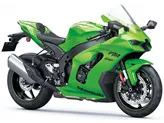Yamaha R1 2015 vs. Suzuki GSX-R 750 2015

Yamaha R1 2015

Suzuki GSX-R 750 2015
Overview - Yamaha R1 2015 vs Suzuki GSX-R 750 2015
The Yamaha R1 2015 and the Suzuki GSX-R 750 2015 are both supersport motorcycles that offer high performance and exhilarating riding experiences. However, there are several key differences between the two models that set them apart.
In terms of engine specifications, the Yamaha R1 2015 boasts a larger bore of 79 mm compared to the Suzuki GSX-R 750 2015's 70 mm bore. This larger bore allows the Yamaha R1 to generate more power, with an engine power of 200 HP compared to the Suzuki's 150 HP. The Yamaha R1 also has a higher torque of 112.4 Nm compared to the Suzuki's 86.3 Nm. Additionally, the Yamaha R1 has a higher compression ratio of 13 compared to the Suzuki's 12.5. These differences in engine specifications result in the Yamaha R1 having a more powerful and responsive engine.
Both motorcycles feature a 4-cylinder engine with DOHC valves and an aluminum frame. However, the Yamaha R1 has a Deltabox frame, while the Suzuki GSX-R 750 has a Twin-Spar frame. The Deltabox frame on the Yamaha R1 is known for its superior rigidity and handling, providing a great racing feeling in the saddle. On the other hand, the Twin-Spar frame on the Suzuki GSX-R 750 offers excellent controllability and a comfortable seating position, even for tall riders.

Yamaha R1 2015
In terms of braking, both motorcycles feature double disk brakes at the front. However, the Yamaha R1's braking stability in the braking zone is considered a weakness, while the Suzuki GSX-R 750's brake pads and lines are criticized for being too lax for racetrack use.
In terms of dimensions and weights, both motorcycles have a similar front tire width of 120 mm and front tire diameter of 17 inches. However, the Yamaha R1 has a wider rear tire width of 190 mm compared to the Suzuki's 180 mm. Both motorcycles have the same rear tire diameter of 17 inches. The Yamaha R1 has a slightly longer wheelbase of 1405 mm compared to the Suzuki's 1400 mm. The seat height of the Yamaha R1 is also higher at 855 mm compared to the Suzuki's 810 mm.
Both motorcycles have a fuel tank capacity of 17 liters, providing a decent range for long rides.

Suzuki GSX-R 750 2015
In terms of strengths, the Yamaha R1 2015 is praised for its crazy sound, rev-happy engine with a strong peak, great racing feeling in the saddle, superior electronics package, and high-quality workmanship. On the other hand, the Suzuki GSX-R 750 2015 is commended for its excellent engine response, great controllability, comfortable seating position even for tall riders, reliable technology, and perfect transmission.
However, both motorcycles have their weaknesses. The Yamaha R1 2015 is criticized for its torque sag in the middle and stability in the braking zone. The Suzuki GSX-R 750 2015 is considered unspectacular at the regulars' table, and its brake pads and lines are deemed too lax for racetrack use. Additionally, the Suzuki has a long final gear ratio, which may impact its performance in certain situations.
In conclusion, the Yamaha R1 2015 and the Suzuki GSX-R 750 2015 are both impressive supersport motorcycles with their own unique strengths and weaknesses. The Yamaha R1 offers a more powerful engine and a superior electronics package, while the Suzuki GSX-R 750 provides excellent engine response and controllability. Ultimately, the choice between the two models will depend on the rider's preferences and priorities.
Technical Specifications Yamaha R1 2015 compared to Suzuki GSX-R 750 2015
Pros and Cons in comparison
Pros and Cons in comparison
Yamaha R1 2015

The new R1 is a big hit and no longer compares to the previous model. This was considered a good country road bike and heavy investments had to be made for excursions to the race track. Now it is the other way round. The new R1 has been developed with a clear focus on the race track. The electronics package seems outstanding, technology freaks will get their money's worth. Yamaha fans have to buy it, they finally have a worthy motorbike. The R1 has slight weaknesses when braking - it becomes a little unstable here. If you want to buy a ready-made racing bike without having to work on the chassis, you'd better go for the R1M. The Öhlins electronic suspension works perfectly and has no weaknesses. For pure racetrack use, the second weakness of the R1 can easily be ironed out. The torque hole in the middle can be easily ironed out with a new mapping.
Suzuki GSX-R 750 2015

The GSX-R 750 is the golden mean in many respects. It offers a level of performance that doesn't overwhelm you on the road, but at the same time gives you a lot of pleasure. On the one hand, it is relatively inexpensive, but on the other hand, it is still fast enough. The GSX-R 750 is a great supersport machine. If you don't value superlatives and just want a good motorbike, go for the GSX-R 750 and use the money you save to treat yourself to race training on the Nordschleife....
Price Comparison Avarage Market Price Yamaha R1 vs Suzuki GSX-R 750
There are a few key differences between a Yamaha R1 2015 and a Suzuki GSX-R 750 2015. It takes less time to sell a Yamaha R1 with 76 days compared to 95 days for a Suzuki GSX-R 750. Since model year 2005 1000PS.de editors have written 80 reviews for the Yamaha R1 and 30 reviews for the Suzuki GSX-R 750 since model year 2005. The first review for the Yamaha R1 was published on 4/28/2003 and now has more than 3,900 views. This compares to more than 4,000 views for the first review on Suzuki GSX-R 750 published on 9/16/2003.

































